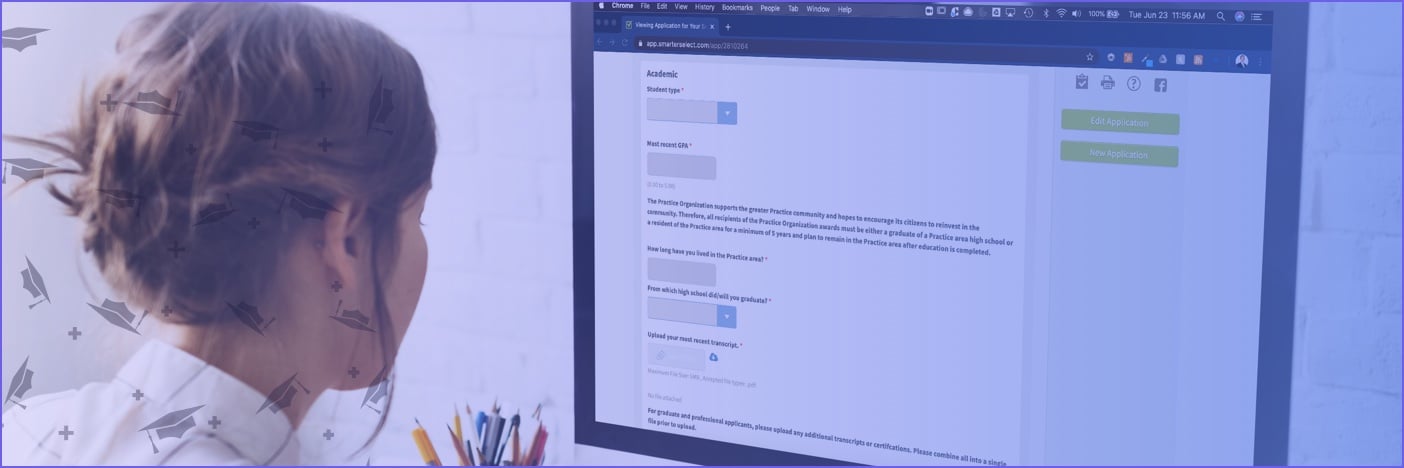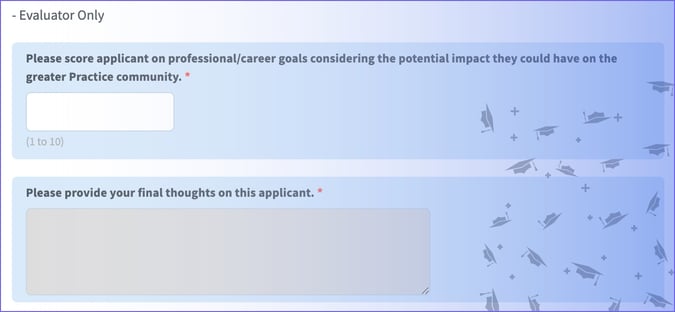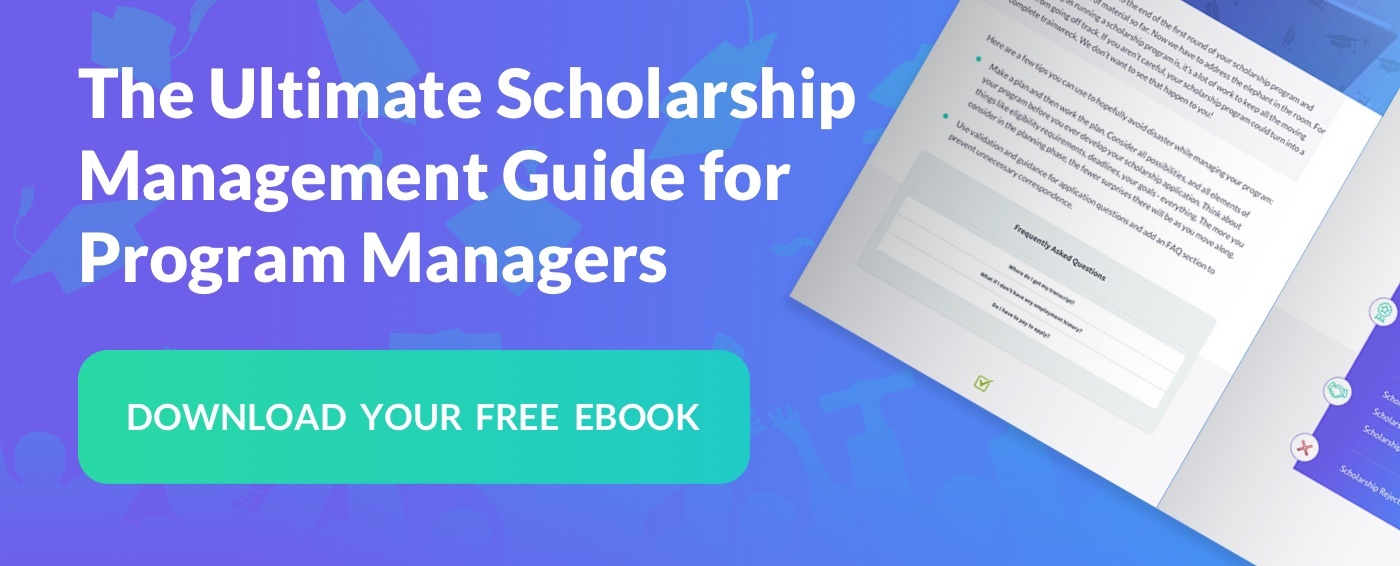Scholarship Management: Dos and Don'ts
No one really likes to discuss this aspect of running a scholarship program, but the reality is, that scholarship management when not handled well can turn into a complete disaster. The question is, what are the main things that can cause a train-wreck, and how can you avoid them?
These dos and don'ts of scholarship management will help you know what you should do and what you should not, to ensure that the scholarship program is successful.
In this post, we’ll explore what can derail your scholarship program, and hopefully, help you to ensure that your scholarship program is a smooth ride from start to finish.
Do: Use Scholarship Management Software
This is perhaps the most important way to avoid a train wreck in running a scholarship program. As you’ll see with the do’s and don’ts that follow, scholarship management software helps you with nearly every aspect of running your program.
We recommend SmarterSelect to assist you with application creation, applicant management, scholarship tracking, organizing applicant data, and streamlining your evaluation process. Our applicant tracking software and intuitive application builder removes the bottlenecks that would otherwise cost you untold amounts of time, energy, and stress.

Don’t: Start a Scholarship Program Without a Plan
We’re the first to admit that you can’t predict every possibility in terms of the things that could come up in scholarship management. However, you can make a plan that can help you address and circumvent many of the issues that could present a problem in the process.
For example, you should consider every piece of information you want from your applicants before you even build your application. There are many questions you need to ask yourself about what your application will include, things like:
- What file formats will be accepted for the submission of recommendation letters, transcripts, community service forms, etc…Something as simple as only allowing PDFs can help you avoid issues with downloading files for evaluation.
- The qualifiers that could determine eligibility such as socioeconomic status, minimum GPA, SAT/ACT scores, age/race/gender of the applicant, major of study, what college they are attending, and more.
- When will your deadlines be, and when do you hope to announce the recipients?
When you don’t have a clear plan or goal, you might find that come deadline or submission time, you have several ineligible applicants, and no clear process for evaluation. No matter how mundane it may seem right now, consider all the possibilities for your application and your entire program overall.
Do: Use a Common Program to Avoid Redundancy
Don't make the applicants fill out the same information on multiple applications. Instead, create a common program with all of the fields needed across all programs and then create unique programs to gather unique information.
Don’t: Allow Anyone and Everyone to Apply
You should have an ideal candidate in mind for your scholarship. Then, you should add pre-qualification questions to pre-screen applicants on individual programs. For multiple programs, use Program Matching in the SmarterSelect software to show applicants only the programs they are qualified to apply for.
Pre-screening will help you eliminate unqualified candidates from the pool of applicants right away, saving countless hours in the evaluation process.
Do: Be Mindful of Donor Intent
When donors give money to a scholarship program, they want to see that it is used the way they intended.
For example, if you are not clear with your program donors that the money could be given to a student majoring in biology, a donor that wants the money to only be given to a student majoring in language arts could be dissuaded from giving to future programs. Or worse, it could cause your donor to speak out publicly against your scholarship!
This is all the more reason you should have a plan and goal in place before you begin your program. Get clear on your ideal recipient, as well as the ideals and values of your program before you seek donations. Doing so will ensure that only the donors that align with your scholarship’s goals and mission will give money to the program.
Don’t: Leave your Evaluators Guessing About How to Score Applications
What deems an application ineligible? Can an incomplete application be eligible for the scholarship? Do you have a clear rubric in place for evaluators?

You should have clear standards in place for your evaluators to filter out applications. Create a crystal clear rubric, and then embed it into the applications and evaluations with SmarterSelect’s Autoscore. Autoscore also makes it so that evaluators don't need to score objective questions.
Using automatic calculators to tally up the scores makes it so there’s no need for any extra calculations like double-checking totals, and by doing so you free up time for your evaluators.
The goal should be to make the evaluation process as easy and stress-free as possible.
Do: Communicate With Your Team and Your Applicants
If a change happens with your scholarship program, you need to keep your evaluation team and your applicants informed. Use our Broadcast messaging and SMS text messages to correspond with everyone about deadlines, evaluation processes, award eligibility, changes in the application, etc…

To go above and beyond, you could even run reports to track where applicants could be having trouble completing their applications, and then send a broadcast to communicate with assistance. For example, you could run a report to:
- Check the status of recommendations.
- Check to see how many essays are incomplete.
- Or, check to see if critical documents (e.g. transcripts, etc.) have been uploaded.
Then, extend a hand to your applicants via broadcasts and alleviate the pain that you know they are experiencing.
Don’t: Haphazardly Create Your Application
There should be a flow to your application. For example, don’t mix unrelated questions in the same section or unrelated sections on the same page, and don’t include all of your questions in one long-form. Instead, create multiple sections and pages.
Make the process easy with less stress for your applicants to complete their application. Organize the application into logical sections and pages, or as we like to call them, “bite-sized chunks”.
For example, Personal Information on page 1, then Academic Information on page 2, then Essays, then Recommendations, etc. This helps the applicant focus on what is important in various parts of the application.
We also recommend adding your request for letters of recommendation earlier in your application. Take it a step further by sending frequent reminders to applicants that have not sent recommendations or have recommendations pending to complete this process.
Do: Use a Section for FAQs
The more information you can give an applicant for them to answer their own questions, and troubleshoot their own issues, the less your team will have to answer panicked emails and phone calls.
Include short assistance text throughout questions within your applications, and also a section with the answers to your most frequently asked questions so that applicants can help themselves.

Don’t: Set the Application Deadline for Submission at Midnight
One thing we have learned from our clients is that 5 p.m./local time is a smarter submission time than midnight because of the inevitable last-minute issues and quotations that come up during the last day.
When your deadline is at midnight, applicants likely won’t be able to reach program administrators since that time is outside of normal office hours. As a result, you could come in the next morning to an unimaginable number of voicemails and emails from panicked applicants who couldn't get help prior to the deadline.
Do: Send Reminders and Stick to Your Deadline
At some point, your deadline will arrive, and you must stick to it. Not only is it important for being fair to the applicants who submitted their application on time, but you also don’t want to delay the start of your evaluation process.
Broadcast frequently about upcoming deadlines, and then lock the applications when the deadline arrives. The sooner you lock everything down, the sooner the evaluations can begin.
Don’t: Go it Alone!
SmarterSelect is built on the premise of efficiency and ease. The user-friendly and flexibility of our scholarship management software allows you to easily create new programs at a moment's notice, without a need for intensive training or testing.
In fact, you could make a copy of a similar scholarship program or even build one from scratch in under an hour (Perfect for emergency programs that spring up due to things like unforeseen circumstances, national emergencies, and even global pandemics like we saw in the wake of COVID-19).
Bottom line: SmarterSelect is simplified scholarship management. We make it easier than ever to create and run an effective scholarship program.
We’ve helped countless program administrators make quick work of their own scholarships, and we can help you too. Click here to download our in-depth scholarship management guide for program managers.
FAQ's
1. What are the dos of scholarship management?
Here are the things you can practice for effective scholarship management:
- Use a scholarship management software.
- Use a common program to avoid redundancy.
- Be mindful of donor intent.
- Communicate with your team and your applicants.
- Have a section for FAQs.
- Send reminders and stick to your deadline.
2. What are the common things to avoid doing in scholarship management?
Here are the don'ts of scholarship management:
- Don’t start a scholarship program without a plan.
- Don’t allow anyone and everyone to apply.
- Don’t leave your evaluators guessing about how to score the scholarship applications.
- Don’t create a haphazard application form.
- Don’t set the deadline for application deadline to an add hour like midnight.



